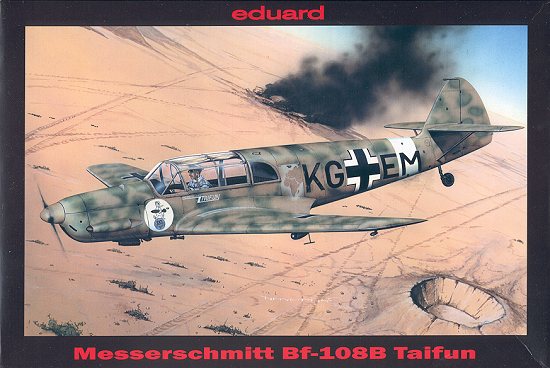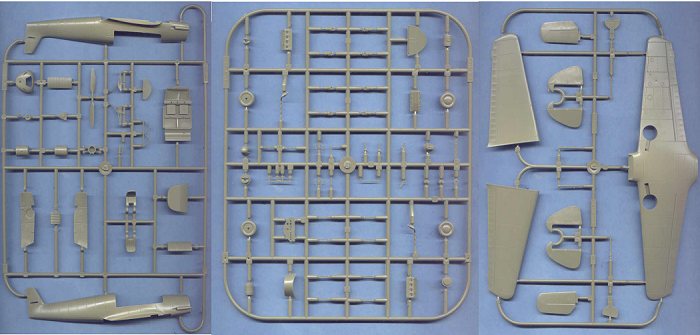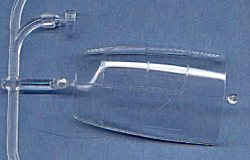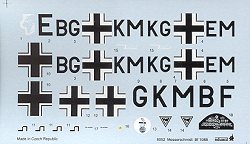
|
KIT: |
Eduard 1/48 Bf-108 |
|
KIT # |
8052 |
|
PRICE: |
$24.95 |
|
DECALS: |
Two aircraft |
|
REVIEWER: |
|
|
NOTES: |
|

|
HISTORY |
Believe it or not, there was a time in German aviation history when Willy Messerschmitt and his company were not only not respected but actively disliked by those in authority. Messerschmitt had originally begun with his own company, and had designed several successful sailplanes and the M.18 all metal monoplane light transport aircraft by 1927, when his company merged with the Bayerische Flugzeugwerke in Augsburg, with Messerschmitt as Chief Designer and still in charge of his own company as a design bureau.
Messerschmitt managed to make a personal enemy of Erhard Milch in 1929 when Milch - then Director of Lufthansa - cancelled all orders for ten 10-seat M.20b transports that had reached an advanced stage of construction, and demanded repayment of the DLH deposits. This forced B.F.W. into bankruptcy in 1931. Messerschmitt Flugzeugbau - which retained rights to all of Messerschmitt's patents - was able to raise sufficient capital and in cooperation with the B.F.W. receiver forced Milch to take delivery of the ten M.20b's and pay for them in full. With this, Messerschmitt was able to re-establish Bayerische Flugzeugwerke on April 27, 1933. By that time, however, things had changed in Germany and his enemy - Milch - was now Hermann Goering's assistant; in early 1934 he was appointed State Secretary of Aviation. One of his avowed goals was to prevent Messerschmitt and his company from achieving the slightest success in German aviation.
In May 1933, B.F.W. accepted a contract from Romania to design and build a light cabin monoplane of advanced concept, the M.37. Oberleutnant Wilhelm Wimmer, a military bureaucrat in charge of the C-Amt (the RLM's Technical Office, which directed German aviation development) who knew his bread was buttered on Milch's side, publicly criticized Messerschmitt for accepting a foreign commission. This hoisted Milch on his own petard when Messerschmitt protested he had to do it because the C-Amt had not given him any kind of a development contract. He then received a contract to develop a competition aircraft for inclusion on the German Team in the coming 1934 Challenge-de-Turisme Internationale.
The M.37 provided a suitable basis on which to develop this airplane, which the RLM gave the designation Bf-108. Messerschmitt and Walter Rethel, who had just left Arado, participated in the design. The first of six 2-seat Bf-108As flew in May 1934, and exceeded all specifications. By this time, Wimmer had been replaced by Oberst Fritz Loeb, who was a supporter of Messerschmitt.
Shortly after the German Team began training with the Bf-108s, one (D-ILIT) crashed. Team Manager Oberstleutnant Theo Osterkamp, who was in Milch's camp, encouraged the rest of the pilots to adopt a negative attitude toward the Bf-108, which was only broken by Loeb's threat to replace Osterkamp, which Milch was forced to support.
At the competition, the Bf-108s only placed fifth, though the airplane made a very creditable showing and demonstrated it was the fastest of all entries. Messerschmitt had already initiated design of the somewhat larger 4-seat Bf-108B "Taifun" (Typhoon); 32 of these were ordered by the RLM. One was later flown by Charles Lindbergh during his controversial visit to Germany, after which he said it was one of the best aircraft in the world in its class.
A total of 180 civil Bf-108s and 626 military versions were produced between 1935 and the end of the Second World War. The Bf-108 was used as a light liason aircraft by all operational Luftwaffe units. Production of the Bf-108D was transferred to France in May 1942, where 170 aircraft were produced for the Germans, with another 115 produced after the liberation of France, and known as the "Nord 1000." These aircraft were used by the French Air Force and Navy until the early 1960s, and they form the majority of the Bf-108s that can still be found flying today. In 1977, I had the privilege of flying one of these one afternoon following that day's Abbotsford Airshow and found it very competitive with the 1947 Bonanza I was then part-owner of, other than that narrow-track landing gear.
With what they had learned on the Bf-108, Messerschmitt and Rethel went on to design the Bf-109, which would become one of the most famous aircraft in history, and completely turn around the fortunes of its maker.
|
THE KIT |

The only other 1/48 kits of the Bf-108 I am aware of was a vacuform from Eagles Talon in the 1980s, and one from Karo-As from the same period; these might have been the same kit re-boxed. Heller produced a very nice kit of this attractive little airplane in 1/72 back in the 1970s, which I have not seen recently but remember as making up into a nice model.
This beautiful kit from Eduard makes anything else obsolete, and demonstrates that the P-39 Airacobra they released last year was no fluke. If anything, this kit is superior to that one, and fully deserving of the "Tamigawa" label. My only complaint about the P-39 was that the trailing edge of the wing was too thick; there is no problem here like that with this kit.
 Molded on three sprues
of light tan plastic like the P-39, the parts of this kit are crisply molded and
sharp in detail, with a very nice fabric effect on the control surfaces.
Molded on three sprues
of light tan plastic like the P-39, the parts of this kit are crisply molded and
sharp in detail, with a very nice fabric effect on the control surfaces.
The cockpit is fully
detailed and allows you the choice of a 4-seat airplane with full rear seat, or
a military 3-seat version with extra fuel tanks in back. A choice of instrument
panels is included, a traditional one with raised detail, and one with the
instrument positions opened and instrument faces included to attach to the rear;
this part, which is molded plastic, is nearly as thin as a photo-etch panel
would be. There is an Argus engine that looks very nice; I don't really
understand why it's there, since the cowl doesn't open, but anyone who wants to
make a model that will stand out from the crowd would have no difficulty opening
the cowl and displaying the engine with more detail added on.
The cockpit canopy is molded in one piece, and too thick to be opened with a realistic look. This isn't really that much of a problem, since it is one of the sharpest clear plastic moldings I have ever seen. Dip it in Future and you will have no trouble seeing all the nice detail in the cockpit.
Decals are provided for two aircraft. One in 70/71/65 and flown by the Luftdienst in 1940, and one in North African desert camouflage of 70/79/78, flown by Sonderkommando Blaich in Libya in 1942.
Editor's note: Tom forgot to mention that you get a set of masks for the canopy, wheels and fuselage stripe. Some of these masks are the type where they provide the outline to a clear bit and you fill in the rest with the tape of your choice. A detailed application sheet is provided for each decal option. There is also an addendum sheet to the instructions as the basic instructions would have you put the engine block in backwards!
|
CONCLUSIONS |
This is one of the nicest kits I have seen in a long time, and fully establishes Eduard as one of the "big three" quality-wise in kit production. The only complaint I have heard from modelers who have started construction is that the fit of the finished cockpit into the fuselage is a bit "fiddly," though I have seen the result and it looks fine.
This is one of those kits I would buy even if I didn't like the airplane (which I do, very much), just because of the quality of the kit. At US$29.95, this represents excellent value for money. It is as well-designed for construction as any Tamiya kit.
Thanks to Eduard for providing this review copy.
If you would like your product reviewed fairly and quickly by a site that has well over 100,000 visitors a month, please contact me or see other details in the Note to Contributors.